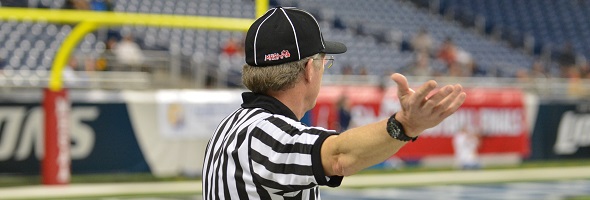
Be the Referee: Covering Knees
September 8, 2016
This week, MHSAA assistant director Mark Uyl explains the increased focus on making sure knee padding is worn correctly in football.
Be The Referee is a series of short messages designed to help educate people on the rules of different sports, to help them better understand the art of officiating, and to recruit officials.
Below is this week's segment – Equipment Covering the Knees - Listen
Everything in the game of football, from a rules-making perspective, starts and ends with an increased focus on player safety.
One big point of emphasis for the 2016 season centers on equipment being worn properly by all players. Too often we see college and pro players, especially those at the skill positions, wearing football pants that come nowhere close to covering the knee area.
With a continued focus on all high school players to lower the target zone when hitting an opponent to keep the head out of football, kids must wear pants with knee pads which completely cover the knee area to avoid those types of injuries.
Past editions
Sept. 1: Play Clock Experiment - Listen
Aug. 25: Clipping in the Free Blocking Zone - Listen

Be the Referee: Catch or No Catch
By
Brent Rice
MHSAA Assistant Director
September 16, 2021
Be The Referee is a series of short messages designed to help educate people on the rules of different sports, to help them better understand the art of officiating, and to recruit officials.
Below is this week's segment – Catch or No Catch - Listen
Catch … or no catch. It’s a decision that must be made in a split second and can be one of the most difficult decisions a football official has to make – especially one along the sidelines.
In high school, for a catch to be considered complete the receiver must:
Have possession and control of the ball AND
One foot or other body part must first come down in bounds.
This means that if you are forced out of bounds while in the air and with possession of the ball, it is NOT a catch. A defender can legally knock an airborne receiver out of bounds to prevent a completion. The receiver has to get one foot – or other body part – down in bounds for it to be ruled a complete catch.
Previous editions
Sept. 9: Intentional Grounding – Listen
Sept. 2: Pass Interference – Listen
Aug. 26: Protocols and Mechanics – Listen

